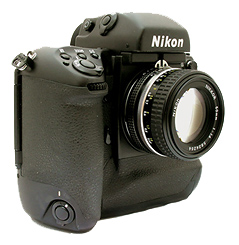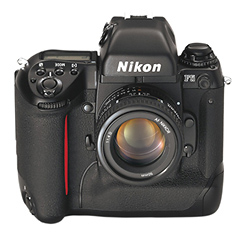
nikon F5 powerful beast
Wolfgang Bleier
Austria, May 2010

Haptic and perception
Without doubt, the F5 was made for professionals, uncompromising and highly durable especially for press, wildlife and sports photography. Soon it was clear to me that such camera in the hands of an amateur is somewhat of an exaggeration. Before the F5 I have used Nikon's F3HP for many years, and I still love taking photographs with the F3.
 Just like the F5 the F3 was a major milestone among Nikon's professional F series, but because of its relatively compact dimensions I never feel such kind of overkill when I take it out. Severe currency devaluation in South-East Asia in 1998 was my chance to get the F5 and some Nikkor-D AF lenses for a bargain, otherwise I doubt I had bought it. Nonetheless, I love taking photographs with the F5, most of all because of its unsurpassed RGB color matrix meter, its ruggedness and easy-to read high-eyepoint viewfinder.
Just like the F5 the F3 was a major milestone among Nikon's professional F series, but because of its relatively compact dimensions I never feel such kind of overkill when I take it out. Severe currency devaluation in South-East Asia in 1998 was my chance to get the F5 and some Nikkor-D AF lenses for a bargain, otherwise I doubt I had bought it. Nonetheless, I love taking photographs with the F5, most of all because of its unsurpassed RGB color matrix meter, its ruggedness and easy-to read high-eyepoint viewfinder.If there is a perfect exposure meter, it's the one of the F5. It' handles even the worst light conditions, say from very well to perfect. The F5's RGB matrix meter has more than 1.000 segment, it can predict the subject and choose the correct metering algorithm far more accurate than any other camera of its time. Should there be a situation requiring classic exposure metering or more creative techniques, the F5 can be quickly changed to (programmable) center weighted metering or spot metering. Its oscillator-controlled shutter provides speeds from 1/8000s to 30s and performs a self-diagnostic routine at every exposure.
 Holding the F5 feels great, its textured rubber coating has a very good grip. The F5 is sturdy, it feels as if milled from a massive block of metal. Its auto focus drives the lens without mercy to focus fast enough for shooting at 8 frames per second - correctly exposed. Single servo or continuous servo AF mode with single area AF or dynamic area AF to keep track of a moving subject - no matter what you want the F5 to do, it will perform. You are also warned: you can easily get fascinated by the F5 and will want to haul this beast around with you all the time. To be clear, the F5 is heavy! It is true that weight helps to reduce camera shake if you do not have a tripod with you when you should have one. All right, but the F5 is really heavy. With a decent Nikkor AF lens mounted it weighs well two kilogram. After some hours with the F5 on your shoulder and some other lenses in the bag it feels like 5 kilograms or more. This is not a camera to be carried along on vacation.
Holding the F5 feels great, its textured rubber coating has a very good grip. The F5 is sturdy, it feels as if milled from a massive block of metal. Its auto focus drives the lens without mercy to focus fast enough for shooting at 8 frames per second - correctly exposed. Single servo or continuous servo AF mode with single area AF or dynamic area AF to keep track of a moving subject - no matter what you want the F5 to do, it will perform. You are also warned: you can easily get fascinated by the F5 and will want to haul this beast around with you all the time. To be clear, the F5 is heavy! It is true that weight helps to reduce camera shake if you do not have a tripod with you when you should have one. All right, but the F5 is really heavy. With a decent Nikkor AF lens mounted it weighs well two kilogram. After some hours with the F5 on your shoulder and some other lenses in the bag it feels like 5 kilograms or more. This is not a camera to be carried along on vacation.Features & Specifications
The list of features and specifications of the F5 is impressive. It is long, very long. Just to think of it to write down all of its (first-rate) data gives me kind of frustration. I could fill pages about this excellent camera, and still not be complete. Instead to wear my fingers to the bone, I have linked a well illustrated F5 brochure published by Nikon in April 2002. This brochure explains the F5 in greater detail and better than I ever could do.
 In spite of its extensive functions and versatility, the Nikon F5 is a very user-friendly camera. For a medium-size man's hand all buttons and levers are in places where expected, and above all the front and rear command dials can be easily to operated by intuition. All information shown in the top and rear LCD display is presented straightforward and easy to understand. You can switch on the F5 and shoot, your hands and fingers will instantly know what to do. The only situation in which I need instructions printed on a small folded card (which came together with the F5) is when I want to change the F5's custom settings. Anyway, this rarely the case. The F5 has two banks to set up custom functions, which in my F5 only differ from each other insofar as one bank gives the shutter priority over the focus in continuous AF mode for faster action shooting.
In spite of its extensive functions and versatility, the Nikon F5 is a very user-friendly camera. For a medium-size man's hand all buttons and levers are in places where expected, and above all the front and rear command dials can be easily to operated by intuition. All information shown in the top and rear LCD display is presented straightforward and easy to understand. You can switch on the F5 and shoot, your hands and fingers will instantly know what to do. The only situation in which I need instructions printed on a small folded card (which came together with the F5) is when I want to change the F5's custom settings. Anyway, this rarely the case. The F5 has two banks to set up custom functions, which in my F5 only differ from each other insofar as one bank gives the shutter priority over the focus in continuous AF mode for faster action shooting.With Nikon's revolutionary 3D color matrix exposure meter it has come to a point that it is almost impossible to get a badly exposed image. The few variables in the simple equation of Shutter Speed + Aperture = Exposure were the main areas where all camera manufacturers have focused their technological progress on, and improved every segment of it during the last 20 years. The outcome is perfect exposure meters that have evolved from this simple equation, but only few people realise the fact that such level of perfection results from just minor differences within an exposure of about 1/3 to 1/2 stop. Combined with a fast autofocus tracking rate of 8 fps managed by the F5, the success rate in action photography has considerably improved in comparison with the performance of professional SLR cameras from the eighties and early nineties. For sports, news or wild life photography it makes a tremendous difference.
To sum up, here are the major attributes I selected for the F5:
domain: action strength: performance quality: exceptional value: reliability
| Specifications | |
Model |
Nikon F5 |
Production period |
1996 - 2004 |
Camera type |
Integral-motor AF 35mm single-lens reflex camera |
Focus control |
Auto focus (single and continuous AF) and manual focus |
AF area modes |
Single area AF and Dynamic AF selectable from 5 focus areas |
Viewfinder |
Large high-eyepoint pentaprism type, 100% frame coverage. Interchangeable Multimeter, 0,70% magnification, eye-point: 20,5 mm, integrated metering system selector, diopter adjustment knob, eyepiece shutter lever. |
Exposure metering |
TTL, 3 built-in exposure meters: 3D color matrix, center weighted (programmable) and spot meter. |
Exposure modes |
Programmed Auto, Shutter-Priority Auto, Aperture-Priority Auto and Manual exposure control. |
Exposure compensation |
+/- 5EV in 1/3 steps |
Auto exposure memory lock |
yes (by pressing AE-L/AF-L button) |
Shutter |
Electromagnetically controlled, vertical-travel metal focal-plane shutter. |
Shutter speeds |
Oscillator-controlled, 30s to 1/8000s (in 1/3 steps). Bulb for long time exposures. |
Film speed range |
DX coded: ISO 25 to ISO 5000, Manual: ISO 6 to ISO 6400 |
Film speed setting |
DX coding, manual ISO setting |
Film loading |
Film automatically advances to first frame. |
Film advance modes |
Motorized Single Frame shooting (S) Motorized Continuous High shooting mode (CH) up to 8 fps Motorized Continuous Low shooting mode (CL) 3 fps Motorized Continuous Silent shooting mode (CS) 1 fps Shooting rates are programmable. Actual shooting rates depend on battery type. |
Film rewind |
Motorized rewind within 4s, Manual film rewind crank |
Viewfinder display |
Focus indication, LCD shows metering system, exposure mode, shutter speed, aperture, electronic analog exposure display (M), frame counter, exposure compensation value and compensation mark, exposure level indicators, LED flash ready light, aperture direct readout, focus indicators and highlighted focus area indicators |
Flash unit connection |
Standard ISO-type accessory hot-shoe |
Flash synchronization |
In P or A mode: from 1/250s to 1/60s in normal sync or 1/250s to 1/30s in slow sync. In S or M mode: synchronization at speed set, or at 1/250s if speed is set between 1/250s and 1/8000s. |
Flash exposure metering |
3D multi-sensor balanced fill flash with Nikkor AF-D lenses and corresponding Speedlight. Monitor pre-flash with Nikkor AF lenses and corresponding Speedlight. |
Flash sync modes |
Synchronization with front curtain (standard), Slow sync and synchronization with rear-curtain built-in. |
Mirror lock-up |
yes |
Depth of field preview |
electromagnetically controlled |
Self timer |
Electronically controlled, 10 sec. |
Multiple exposure |
yes |
Power |
8 AA-type 1,5V batteries, or Ni-MH re-chargeable Battery Unit MN-30 |
Other features |
Auto focus detection, auto focus tracking, Auto focus and exposure value lock, Metering range: EV0 to EV20 in 3D color matrix metering, Self-diagnostic featuring Nikon's shutter monitor, 14 interchangeable focusing screens available, Top and Rear LCD information panel, Easy, intuitive operation with front and rear command dial, Custom settings of 24 functions in 2 groups, Personal Computer interface, Weight: 1.210 g |